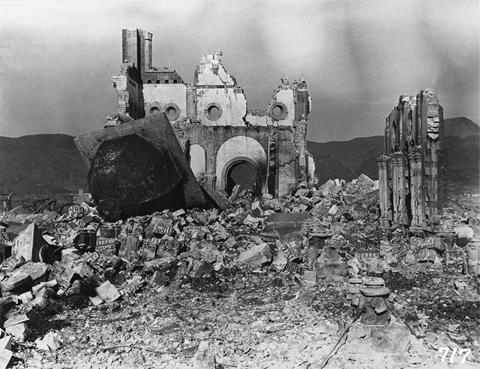When American aviators used the cathedral in Nagasaki to guide the dropping of the atomic bomb that ended the second world war, they wiped out a Christian community that had survived hundreds of years of persecution. This is the untold story of Oppenheimer, says Professor Nick Megoran

The story of the design, testing and use of atomic weapons is the theme of Christopher Nolan’s highly acclaimed summer film, Oppenheimer. J Robert Oppenheimer’s first atomic bomb was detonated at a New Mexico test site on July 16 1945. Codenamed ‘Trinity’, was the nickname blasphemous, or a stroke of theological genius?
Perhaps surprisingly, some Christians welcomed the dawn of the atomic age. In 1946 Catholic priest, scientist and philosopher, Pierre Teilhard de Chardin, wrote an essay about what he called “the spiritual repercussions of the atom bomb.” He said that a new humanity was born after “that famous sunrise” when Oppenheimer’s team successfully tested ‘Trinity’. Its destructive power “must render all armed conflict impossible,” he reasoned, adding that the scientific challenge of taming atomic energy would inevitably draw humanity “together in an atmosphere of sympathy.”
Moment in time
With the benefit of hindsight, this is obviously ridiculous. But de Chardin was trying to capture in words what Nolan manages to portray so brilliantly on film – that the mesmerising spectacle of splitting the atom was a truly epochal moment in history, when humans used their God-given powers of intellect to achieve something remarkable.
At 11:02 am, Nagasaki Christianity was boiled, evaporated and carbonised in a scorching, radioactive fireball
De Chardin’s mistake was to confuse this with the coming of the kingdom of God. For the Christians who lived in Nagasaki until August 9 1945 - when Oppenheimer’s third bomb, ‘Fat boy’, was dropped on it - no such error was possible.
A history of Japanese Christianity
In the 16th century, Spanish missionary Francis Xavier planted a thriving church in Nagasaki. However, Japanese rulers came to see Christianity as a threat, and subjected our brothers and sisters in the faith to horrific persecution. Christians were arrested, tortured and crucified if they refused to abandon their faith.
It appeared that the rulers had succeeded in their aim of wiping out Japanese Christianity. However, in the late 19th century, Japan began a process of liberalising and modernising. It was discovered that there were thousands of secret believers who had been quietly living out their faith unknown to the authorities. Theirs is one of the most amazing stories of endurance under persecution in Church history.
This underground church emerged and built St Mary’s cathedral in the Urakami district of Nagaski to worship Jesus and proclaim the gospel openly. Tragically, it also sealed their fate. The cathedral was used by the airmen carrying the atomic bomb to target their payload. Dr Gary Kohls describes what happened next:
“At 11:02 am, Nagasaki Christianity was boiled, evaporated and carbonised in a scorching, radioactive fireball. The persecuted, vibrant, faithful, surviving center of Japanese Christianity had become ground zero. And what the Japanese Imperial government could not do in over 200 years of persecution, American Christians did in nine seconds.” According to some estimates, about 8,500 of Nagasaki’s 15,000 Christians were killed.
There’s a further, terrible twist in the Christian tragedy of Nagasaki. A young American chaplain, George Zabelka, had the dubious honour of supporting and blessing the airmen who dropped the bomb. At the time, he thought little of it, as he had often heard sermons extolling the war as a righteous struggle.
But Zabelka’s views changed when he visited hospitals in Nagasaki and saw people dying of radiation exposure. He heard about the now-destroyed Christian church of Nagasaki, and was disturbed to learn that he, as a Christian leader, had encouraged Christian crewmen to kill their fellow believers (not to mention all the other Japanese people) in such numbers.
Just war
Jesus told his disciples “to love one another” (John 13:34) but we’d never have guessed as much by the evidence of Nagasaki. Zabelka came to conclude that by its terrible doctrine of ‘just war theory,’ the Christian Church “had prepared the moral consciousness of humanity to do and justify the unthinkable.” He devoted the rest of his life to working for peace.
Splitting the atom was an epochal moment in history, when humans used their God-given powers of intellect to achieve something remarkable
Oppenheimer’s second atomic bomb, ‘Little Boy’, was dropped on Hiroshima three days earlier, on August 6 1945. In the traditional Christian calendar, the date marks the Feast of the Transfiguration, when we remember how Jesus’ face “shone like the sun” as the humble Son of God was bathed in divine glory (Matthew 17:2).
The Christian hope for the world is in the glorious, liberating sunshine of the love of Christ, not the deadly conflagration of weapons of mass destruction.
That’s why Oppenheimer is a must-see film for any thinking Christian: it reminds us how much damage we can do when we trust in the power of the sword rather than the power of the cross. With Christian churches continuing to support ‘their side’ in wars and conflicts around the world, it is a lesson we are still failing to learn.
Perhaps Nolan’s film can help us read the Bible more accurately.





































No comments yet